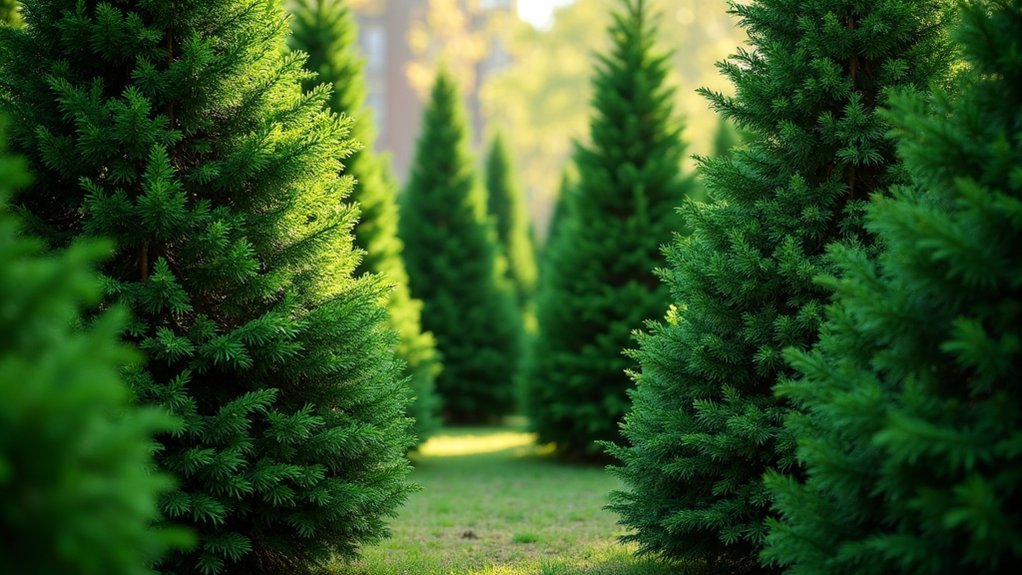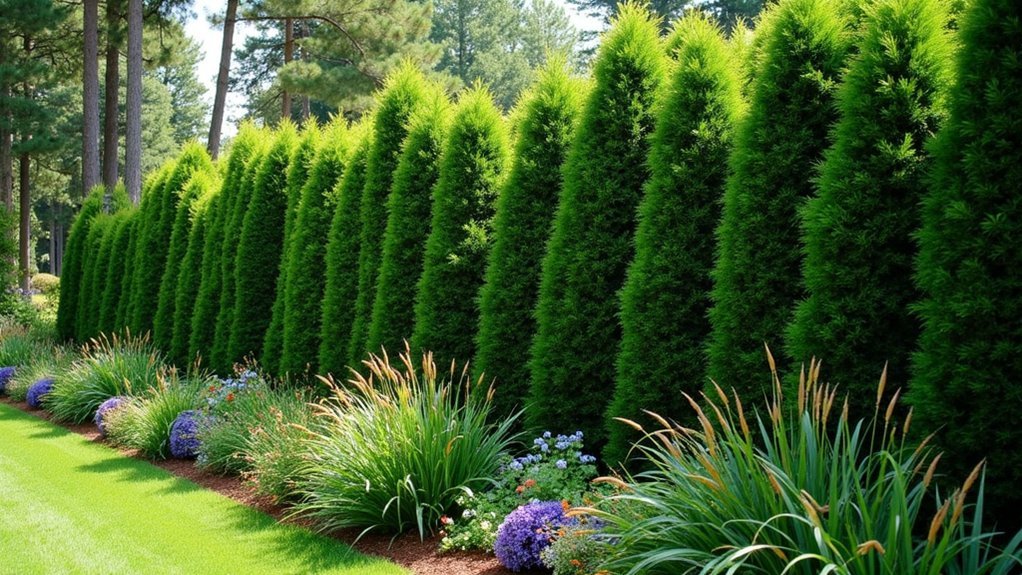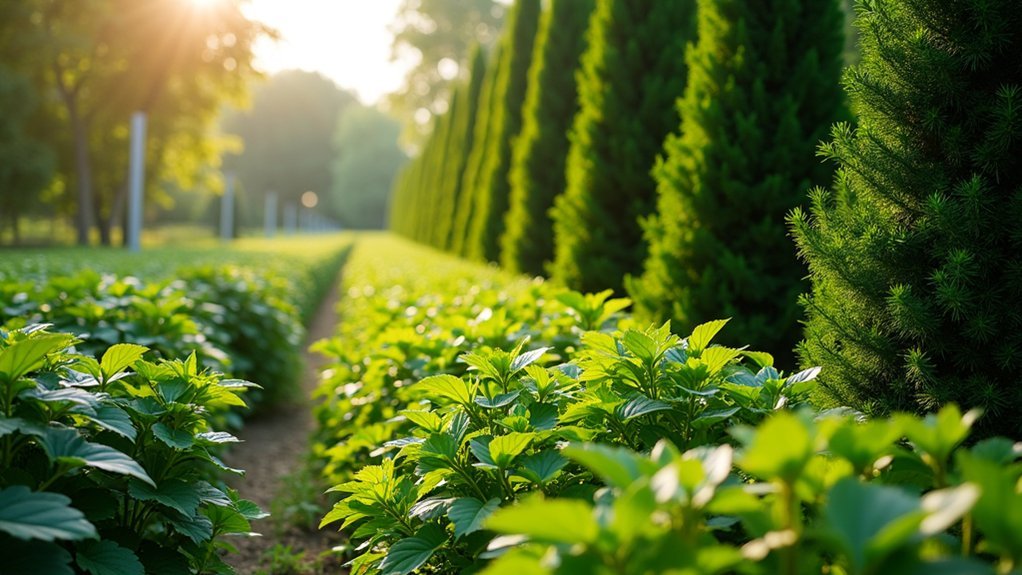For quick noise buffer plantings, start with dense evergreens like Thuja Green Giant or Leyland Cypress that absorb sound waves effectively. Layer your landscape with fast-growing trees and low shrubs to create multiple sound barriers. Don’t overlook container options for immediate, flexible solutions in tight spaces. Keep plantings dense through regular pruning and deep watering. Consider strategic placement around your property’s perimeter for maximum noise reduction. The following strategies can transform your outdoor sanctuary from noisy to peaceful.
Dense Evergreens: Your First Line of Sound Defense

When it comes to creating a natural sound barrier around your property, dense evergreens stand as the undisputed champions.
Varieties like Thuja Green Giant and Leyland Cypress offer exceptional noise reduction capabilities thanks to their thick foliage that effectively absorbs and deflects sound waves from traffic noise.
Dense evergreen varieties create natural sound shields, their thick foliage absorbing and redirecting traffic noise before it reaches your sanctuary.
These powerhouse trees grow rapidly, reaching 40-60 feet tall, and maintain their noise barrier effectiveness year-round—unlike deciduous trees that lose their sound-dampening abilities in winter.
For maximum protection against unwanted noise, consider implementing a layered planting approach with multiple rows of evergreens at varying heights.
To keep your living sound buffer thriving, don’t neglect regular maintenance.
Deep watering during dry periods and occasional fertilization will guarantee your evergreen barrier remains dense and effective at blocking highway sounds.
Fast-Growing Trees and Shrubs for Immediate Results
While evergreens provide excellent long-term noise protection, you don’t need to wait years for relief from unwanted sound. Fast-growing trees like Thuja Green Giant can shoot up over 5 feet annually, creating dense foliage that greatly reduces noise levels in your garden.
For impressive height, consider Leyland Cypress, which reaches 40-60 feet within a few years, forming an effective sound barrier against persistent noise pollution. Italian Cypress grows up to three feet yearly, offering symmetrical planting design options while buffering unwanted sound.
Don’t overlook shrubs in your noise reduction landscaping plan. Nellie Stevens Holly grows up to 25 feet tall with glossy foliage that absorbs sound waves.
Boxwood and viburnum establish quickly, enhancing privacy while diminishing neighborhood noise—giving you immediate results from your evergreen trees investment.
Strategic Layering Techniques for Maximum Noise Reduction

Three distinct planting layers create the most efficient natural sound barrier for your property.
Begin with a foundation of dense shrubs like boxwood or viburnum arranged in staggered rows to deflect and absorb sound waves. This base layer serves as your primary noise barrier against traffic sounds.
Add a middle layer of ornamental grasses, which provide additional sound absorption through their complex leaf structures that break up noise frequencies. Their movement also helps scatter mid-frequency sounds effectively.
Complete your strategic layering with tall evergreens for year-round coverage, complemented by deciduous trees for seasonal variation.
Position these layers to work with any existing structure on your property, maximizing the acoustic performance of your landscape. This three-tiered approach guarantees sound waves are intercepted at multiple heights for ideal noise reduction.
Container Planting Solutions for Instant Noise Barriers
Container planting offers a flexible alternative to permanent landscape installations for homeowners seeking immediate noise relief.
Embrace the adaptability of container gardens for quick, effective noise management without permanent landscape commitments.
You’ll find that strategic placement of dense, sound-absorbing foliage like boxwood or holly in durable fiberglass planters creates effective low barriers that dampen unwanted noises while enhancing your outdoor aesthetic.
Arrange raised planter beds around noise sources to improve acoustic performance and add visual interest to your landscape.
For thorough noise blocking, consider utilizing tall potted plants that intercept and scatter mid-frequency sounds at various heights.
When ground space is limited, modular green walls constructed from stacked planter boxes provide vertical solutions that maximize sound absorption.
This approach allows you to customize your noise barrier according to your specific needs while maintaining design flexibility throughout your space.
Maintenance Strategies to Enhance Sound-Blocking Effectiveness

Effective noise barriers require consistent maintenance to maximize their sound-dampening capabilities. Regular pruning of dense shrubs like boxwood maintains thickness, ensuring they properly absorb sound while breaking the line of sight from ambient noise sources.
Implement a spring fertilization schedule with slow-release products to promote robust growth that acts as natural soundproofing material. Water deeply twice weekly for newly planted hedges to establish strong roots essential for noise reduction.
Layer your plantings strategically—tall shrubs backed by shorter species and Ground Cover—to create barriers particularly effective at different frequencies. Monitor for gaps in your living fence, as these allow external noise to penetrate.
Fill sparse areas promptly with additional plants to maintain continuous coverage, greatly improving your barrier’s overall performance and sound-dampening properties.
Frequently Asked Questions
What Is the Best Natural Sound Barrier?
Dense evergreen trees like Thuja Green Giant and Leyland Cypress are your best natural sound barriers. They’ll grow quickly and provide year-round coverage, effectively absorbing and deflecting noise pollution around your property.
How to Create a Sound Barrier With Landscaping?
To create a sound barrier with landscaping, you’ll want to plant dense evergreens in layered rows, combining tall trees with thick shrubs. Add hardscape elements like fences behind your plantings for maximum noise reduction.
What Is the Best Sound Barrier for a Garden?
The best sound barrier for your garden combines layered plantings of dense evergreens like Thuja with acoustic fencing. You’ll get ideal noise reduction when you add water features that mask unwanted sounds with soothing white noise.
What Vegetation Is Best for Noise Reduction?
For noise reduction, you’ll want dense evergreens like Thuja Green Giant or Leyland Cypress, combined with layered shrubs such as boxwood and holly. Don’t forget to add groundcovers like creeping thyme for complete sound absorption.
In Summary
You’ll find that strategic noise buffer plantings can transform your outdoor space from noisy to peaceful. Remember to prioritize dense evergreens, choose fast-growing varieties, layer your plants strategically, use containers for flexibility, and maintain your living sound barrier regularly. With these quick solutions, you’ll enjoy a quieter environment without waiting years for results. Start implementing these tips today for immediate relief from unwanted noise.





Leave a Reply